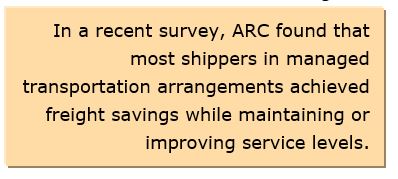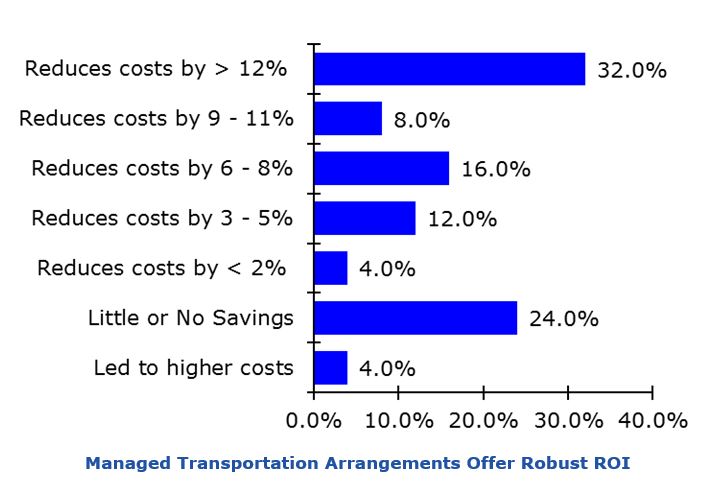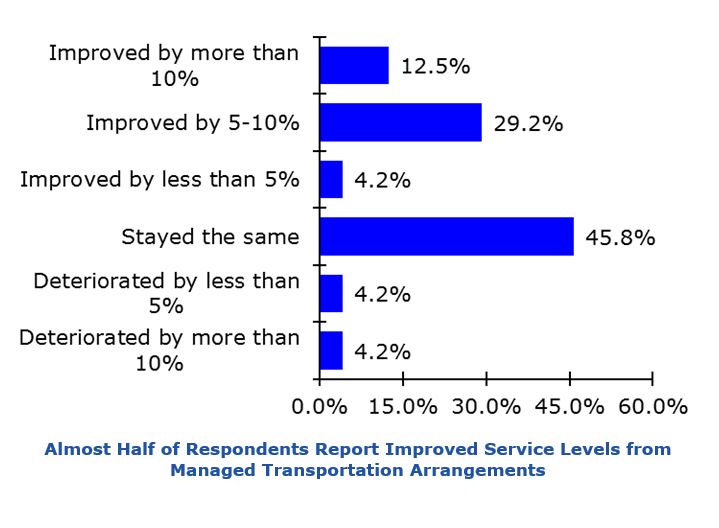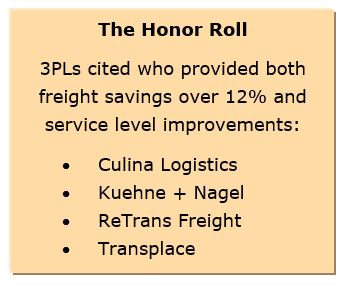

 Overview
OverviewMost managed transportation arrangements have successfully reduced freight spend for shippers while maintaining or improving service levels. This ARC Insight examines the benefits and risks of these arrangements and points out some of the practices that tend to show that managed transportation ROI keeps on truckin’.
ARC Advisory Group recently did a survey in conjunction with DC Velocity and eft (formerly eyefortransport) on the types of solutions and services shippers use to manage their transportation. In total, 119 respondents provided answers for the survey. Most respondents came from North America. Forty-four percent of respondents reported that managed service providers managed more than 20 percent of their freight spend.
A managed transportation arrangement is one in which shippers outsource transportation planning and execution to a service provider. These arrangements typically yield good ROI, which appears to have improved further since we last did this survey two years ago. In our earlier survey, 9 percent of respondents reported more than 12 percent freight savings from these arrangements. However, at that time, 11 percent of respondents reported that the managed transportation arrangement actually increased their freight costs. In contrast, in this year’s survey, 32 percent of respondents reported savings of 12 percent or more! Only 4 percent of respondents reported that the managed transportation arrangement increased their costs.
In one question, ARC asked: “If you were to stop working with your managed service provider and went back to doing things the way you used to before this relationship, how much would your freight costs be raised or lowered in the following year?” We also asked respondents to assume that the number of loads and cost of fuel would remain about the same year to year.

Subsequent analysis showed that the relative ROI of managed transportation related to whether or not the third-party logistics (3PL) provider used a transportation management system (TMS). Managed transportation arrangements that delivered freight savings of more than 12 percent almost always included a TMS implementation rather than the use of transportation execution system with limited optimization capabilities. In most cases when a TMS was implemented, the shipper allowed the 3PL to use their standard TMS rather than specifying the TMS to be implemented.
Savings associated with strategic procurement negotiations are a key source of freight savings. There are different ways to manage strategic procurement negotiations. The shipper can choose to take the lead on selecting carriers and managing the carrier relationship. Or the shipper may choose to take advice from the 3PL on carrier selection, but chose to manage the carrier relationship themselves. Or shippers can choose to give their managed transportation provider more control in procurement negotiations either by letting the 3PL advise them in the selection and then manage the relationship with the carrier, or by giving the 3PL the job of selecting carriers and managing the relationships. Shippers that gave more responsibility to their managed service provider surrounding strategic procurement were much more likely to get better freight savings.
Managed transportation arrangements are based upon different operating models. In some cases, the 3PL also acts as a broker and has secured agreement from the shipper to broker some loads into their network. Some 3PLs are also carriers and these managed service arrangements include the understanding that a portion of the loads will be brokered to transportation assets owned by the 3PL. Finally, some managed transportation arrangements are pure outsourced service agreements with no incremental revenues flowing to the 3PL. We found no relationship between freight savings realized and the type of outsourced service arrangement in place.

Service is also a key consideration. Few shippers would be happy if costs went down at the expense of customer service. ARC 
Managed transportation arrangements had other benefits as well. More than half of respondents reported that their ability to secure capacity improved.
In conclusion, managed transportation arrangements usually provide cost savings without reducing service levels. The most successful projects were ones in which shippers worked with 3PLs that had implemented transportation management systems and relied heavily on 3PLs to select carriers and manage those relationships.
There is always an element of risk inherent in these relationships. ARC asked, “If the 3PL relationship comes to an end, will your company own the transportation software and be able to continue to use this solution internally?” Only 29 percent of respondents said that was the case.
To help shippers make better-informed decisions in this area, ARC has developed TMS Evaluation and Selection Guides and related services. ROI research can be an important driver in the criteria used in supplier selections.
Keywords: Managed Transportation, ROI, Third-Party Logistics, 3PL, ARC Avisory Group.
Please Contact Us

